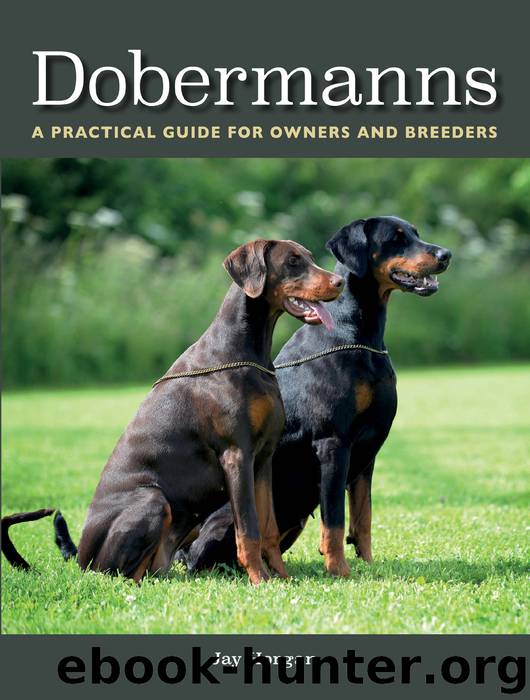Dobermanns by Jay Horgan

Author:Jay Horgan
Language: eng
Format: epub
Publisher: The Crowood Press
PRESERVATIVES (ANTI-OXIDANTS) IN PROCESSED FOODS
Preservatives (anti-oxidants) in processed foods can be synthetic or natural. ‘E’ indicates EU-approved preservatives, and are usually labelled as EEC- or EU-permitted anti-oxidants and preservatives. The most common preservatives used in pet food are BHA (E320), BHT (E321) and Ethoxyquin (E324).
Ethoxyquin: Developed as a rubber stabilizer, and an insecticide. In studies on pregnant animals it has been found to cause gross birth deformities. In 2012 the FDA issued an industry reminder stating ‘if Ethoxyquin is added to an animal feed, either directly or indirectly (as the component of an ingredient), this information must appear on the label.’
Butylated Hydroxytoluene (BHT) and Butylated Hydroxyanisole (BHA): Used to stop fat becoming rancid. The US DHHS classify them as ‘reasonably anticipated to be a human carcinogen’. BHA is banned in infant foods throughout the EU, and in Japan. BHA/BHT is used in 9 per cent of kibble.
Propylene glycol: A preservative often used in semi-moist kibble to maintain water content and texture. It is an ingredient in anti-freeze (along with ethylene glycol) and can be fatal to dogs and cats which are attracted to licking the sweet tasting solution.
Propyl Gallate (E310): An anti-oxidant banned from children’s foods in the US because it is thought to cause blood disorders.
Synthetic anti-oxidants: Often added pre-mixed, enabling some manufacturers to misleadingly claim ‘No added colourants or synthetic preservatives’, on the basis that if they didn’t put the preservative in there themselves, they don’t have to list it amongst their product ingredients.
Sodium nitrate: A mineral salt powder found in processed meat to prevent it turning grey. It is a flavour enhancer and preservative, and increases the weight of the meat. Salt causes water retention, which raises blood pressure and places strain on the heart and other organs. Studies on pregnant mammals showed that ‘high levels of nitrite result in foetal loss, lower litter numbers and neonatal mortality.’ (Ref. Fan A.M., Willhite C.C., Book S.A. Regul Toxicol Pharmacol, 1987.
Colours: Added to make pet food attractive to the owner. Red No. 2 and Violet No. 1 dyes were banned from human foods in the 1970s as they were linked to cancer, birth defects and skin lesions. In 2008 the UK FSA banned six food colours that were found to increase hyperactivity in children. This ban was later replicated in the EU, but is not yet implemented in the USA. There are no legal limits on the use of colours in dog food.
More on Preservatives
If a food is synthetically preserved, Burns Pet Foods® calculate that the average 25lb dog will consume 6–9lb of chemical preservatives a year. With the bodyweight for the Dobermann being double that, the average Dobermann therefore consumes around 18lb of toxins annually
Wet (canned or pouch) food contains fewer synthetic preservatives because ingredients are sealed and prevented from oxidizing and degrading. Some smaller producers steam-cook foods to maintain natural vitamin and mineral values
Choose foods that are preserved naturally. Buy smaller bags as the shelf life is shorter
Download
This site does not store any files on its server. We only index and link to content provided by other sites. Please contact the content providers to delete copyright contents if any and email us, we'll remove relevant links or contents immediately.
Finding Gobi by Dion Leonard(2781)
Grumpy Cat by Grumpy Cat(2687)
A New Earth: Awakening to Your Life's Purpose by Eckhart Tolle(2597)
The Silkworm by Robert Galbraith(2443)
Tippi by Tippi Hedren(2184)
End of Days by Sylvia Browne(2118)
Total Cat Mojo by Jackson Galaxy(1968)
Backyard Chickens Beyond the Basics by Pam Freeman(1905)
The Animals Among Us by John Bradshaw(1831)
The Ultimate Pet Health Guide by Gary Richter(1728)
All Things Bright and Beautiful by James Herriot(1709)
Vet in Harness by James Herriot(1665)
Doggy Desserts: 125 Homemade Treats for Happy, Healthy Dogs by Cheryl Gianfrancesco(1655)
Dog Years by Mark Doty(1643)
Cesar's Way by Cesar Millan(1635)
Chicken Soup for the Ocean Lover's Soul by Jack Canfield(1602)
Dog Training 101 by Kyra Sundance(1560)
Walking with Peety by Eric O'Grey(1555)
Animal Speak by Ted Andrews(1514)
